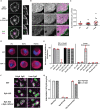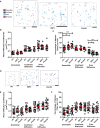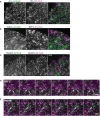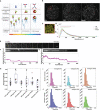Engineered IgG1-Fc Molecules Define Valency Control of Cell Surface Fcγ Receptor Inhibition and Activation in Endosomes
- PMID: 33679705
- PMCID: PMC7928370
- DOI: 10.3389/fimmu.2020.617767
Engineered IgG1-Fc Molecules Define Valency Control of Cell Surface Fcγ Receptor Inhibition and Activation in Endosomes
Abstract
The inhibition of Fcγ receptors (FcγR) is an attractive strategy for treating diseases driven by IgG immune complexes (IC). Previously, we demonstrated that an engineered tri-valent arrangement of IgG1 Fc domains (SIF1) potently inhibited FcγR activation by IC, whereas a penta-valent Fc molecule (PentX) activated FcγR, potentially mimicking ICs and leading to Syk phosphorylation. Thus, a precise balance exists between the number of engaged FcγRs for inhibition versus activation. Here, we demonstrate that Fc valency differentially controls FcγR activation and inhibition within distinct subcellular compartments. Large Fc multimer clusters consisting of 5-50 Fc domains predominately recruited Syk-mScarlet to patches on the plasma membrane, whereas PentX exclusively recruited Syk-mScarlet to endosomes in human monocytic cell line (THP-1 cells). In contrast, SIF1, similar to monomeric Fc, spent longer periods docked to FcγRs on the plasma membrane and did not accumulate and recruit Syk-mScarlet within large endosomes. Single particle tracking (SPT) of fluorescent engineered Fc molecules and Syk-mScarlet at the plasma membrane imaged by total internal reflection fluorescence microscopy (SPT-TIRF), revealed that Syk-mScarlet sampled the plasma membrane was not recruited to FcγR docked with any of the engineered Fc molecules at the plasma membrane. Furthermore, the motions of FcγRs docked with recombinant Fc (rFc), SIF1 or PentX, displayed similar motions with D ~ 0.15 μm2/s, indicating that SIF1 and PentX did not induce reorganization or microclustering of FcγRs beyond the ligating valency. Multicolor SPT-TIRF and brightness analysis of docked rFc, SIF1 and PentX also indicated that FcγRs were not pre-assembled into clusters. Taken together, activation on the plasma membrane requires assembly of more than 5 FcγRs. Unlike rFc or SIF1, PentX accumulated Syk-mScarlet on endosomes indicating that the threshold for FcγR activation on endosomes is lower than on the plasma membrane. We conclude that the inhibitory effects of SIF1 are mediated by stabilizing a ligated and inactive FcγR on the plasma membrane. Thus, FcγR inhibition can be achieved by low valency ligation with SIF1 that behaves similarly to FcγR docked with monomeric IgG.
Keywords: Fcγ receptor; antibodies; autoimmunity; immune complex; inhibitor; macrophage; monocyte; single molecule.
Copyright © 2021 Bailey, Choudhury, Vuppula, Ortiz, Schaeck, Manning, Bosques and Hoppe.
Conflict of interest statement
AC, DO, JS, AM, and CB were employed by Momenta Pharmaceuticals during the project and have equity interest. CB, AM, and DO are inventors on patent application PCT/US2015/028926 (WO/2015/168643) submitted by Momenta Pharmaceuticals that covers “Compositions and methods related to engineered Fc constructs”. The remaining authors declare that the research was conducted in the absence of any commercial or financial relationships that could be construed as a potential conflict of interest.
Figures







Similar articles
-
TIRF imaging of Fc gamma receptor microclusters dynamics and signaling on macrophages during frustrated phagocytosis.BMC Immunol. 2016 Mar 12;17:5. doi: 10.1186/s12865-016-0143-2. BMC Immunol. 2016. PMID: 26970734 Free PMC article.
-
Elucidating the interplay between IgG-Fc valency and FcγR activation for the design of immune complex inhibitors.Sci Transl Med. 2016 Nov 16;8(365):365ra158. doi: 10.1126/scitranslmed.aaf9418. Sci Transl Med. 2016. PMID: 27856797
-
An Engineered Human Fc variant With Exquisite Selectivity for FcγRIIIaV158 Reveals That Ligation of FcγRIIIa Mediates Potent Antibody Dependent Cellular Phagocytosis With GM-CSF-Differentiated Macrophages.Front Immunol. 2019 Mar 27;10:562. doi: 10.3389/fimmu.2019.00562. eCollection 2019. Front Immunol. 2019. PMID: 30984171 Free PMC article.
-
Functional diversification of IgGs through Fc glycosylation.J Clin Invest. 2019 Sep 3;129(9):3492-3498. doi: 10.1172/JCI130029. J Clin Invest. 2019. PMID: 31478910 Free PMC article. Review.
-
The immunoglobulin, IgG Fc receptor and complement triangle in autoimmune diseases.Immunobiology. 2012 Nov;217(11):1067-79. doi: 10.1016/j.imbio.2012.07.015. Immunobiology. 2012. PMID: 22964232 Review.
Cited by
-
Fc Binding by FcγRIIa Is Essential for Cellular Activation by the Anti-FcγRIIa mAbs 8.26 and 8.2.Front Immunol. 2021 Oct 25;12:666813. doi: 10.3389/fimmu.2021.666813. eCollection 2021. Front Immunol. 2021. PMID: 34759915 Free PMC article.
-
Biochemical and biophysical mechanisms macrophages use to tune phagocytic appetite.J Cell Sci. 2025 Jan 1;138(1):JCS263513. doi: 10.1242/jcs.263513. Epub 2025 Jan 3. J Cell Sci. 2025. PMID: 39749603 Review.
-
Antibody surface mobility amplifies FcγR signaling via Arp2/3 during phagocytosis.Biophys J. 2024 Aug 6;123(15):2312-2327. doi: 10.1016/j.bpj.2024.01.036. Epub 2024 Feb 5. Biophys J. 2024. PMID: 38321740 Free PMC article.
References
-
- Murphy KW. Casey, Janeway"s Immunology. Vol. 9 Vol. 924. New York and London: Garland Science Taylor and Francis Group; (2017).
-
- Ushio A, Arakaki R, Yamada A, Saito M, Tsunematsu T, Kudo Y, et al. . Crucial roles of macrophages in the pathogenesis of autoimmune disease. World J Immunol (2017) 7(1):1–8. 10.5411/wji.v7.i1.1 - DOI
Publication types
MeSH terms
Substances
Grants and funding
LinkOut - more resources
Full Text Sources
Other Literature Sources
Research Materials
Miscellaneous

